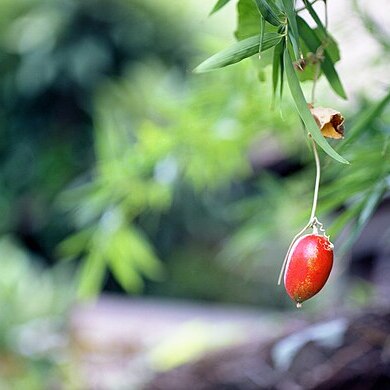Dioecious, apparently annual; stems to several metres long, pubescent. Tendrils 2-branched. Leaves ovate; lamina 7–14 cm long, 7–13 cm wide, mostly unlobed, denticulate, acute, mucronate, rarely shallowly 3-lobed, pubescent on both sides with uni-and multicellular hairs, sparsely so above; petiole 3–9 cm long. Male flowers in 2–10-flowered racemes 3–13 cm long, sparsely to densely glandular-hairy; peduncle 2–7 cm long; bracts narrowly ovate to obovate, acute, 4–7 mm long; pedicels 5–12 mm long, rarely solitary; hypanthium 24–30 mm long; calyx lobes narrowly triangular, 3–5 mm long, rarely denticulate; corolla lobes triangular to ovate, 5–10 mm long, the fringe to 25 mm long. Female flowers not seen. Fruit ovoid, 4–6 cm long, 3–4 cm diam., red; pedicel 1.5–2 cm long. Seeds numerous, 3-locular, broadly ovate, 5–7 mm long, tumid, grooved between locules, pale brown.
Dioecious. Stems climbing to several metres, sparsely pubescent. Tendrils 2-branched. Leaves broadly ovate to suborbicular, cordate at base; lamina 7–15 cm long, 6–15 cm wide, unlobed to deeply 3–5-lobed; lobes ovate to obovate, denticulate, obtuse or acute, mucronate; scabrid above, densely pubescent to velvety beneath; petiole 2–6 cm long. Male flowers in 4–12-flowered racemes 6–20 cm long; peduncle 3–10 cm long; bracts narrowly obovate, acute, 5–10 mm long, dentate; pedicels 5–20 mm long; hypanthium 15–35 mm long; calyx lobes narrowly triangular, 4–8 mm long; corolla-lobes triangular to ovate, 5–8 mm long; fringe to 25 mm long. Female flowers: pedicels 2–3 cm long. Fruit ovoid to ellipsoidal, attenuate, 8–10 cm long, 2.5–3 cm diam., glabrous. Seeds many, 3-locular, broadly ovate, 6–8 mm long, tumid, grooved between locules, brown.
A pumpkin family plant. It is a climbing vine. The stems are slender and grooved. They are hairy. The leaves are oval or round and 5-13 cm long by 5-12 cm wide. They are pale green underneath. The fruit are oval and orange to red. They are 6-7 cm long by 4-6 cm wide. They are smooth and have a beak.

